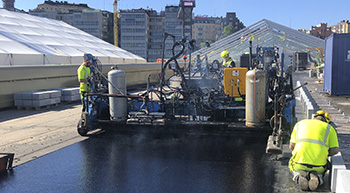Golden standard for Slussen bridge, Sweden
The pavement system for a new bridge includes both asphalt and waterproofing. This makes major demands of quality awareness and the ability to coordinate different technologies.
The pavement system for a new bridge includes both asphalt and waterproofing. This makes major demands of quality awareness and the ability to coordinate different technologies.
Surfacing a new bridge on which the asphalt has to both withstand deformation and protect the underlying steel structure.
Mastic asphalt with Nynas Endura N7 as protective and binder course, as well as a polymer modified asphalt in the surface course.
A flexible pavement with good wear resistance and a long useful life.
 The bridge, which weight 3,400 tonnes, was manufactured in one piece and transported over the course of two months on a special ship from China to Stockholm.
The bridge, which weight 3,400 tonnes, was manufactured in one piece and transported over the course of two months on a special ship from China to Stockholm.
 The pavement is expected to have a service life of 30 years, depending to some extent on how the surface course is maintained.
The pavement is expected to have a service life of 30 years, depending to some extent on how the surface course is maintained.
Next to Gamla Stan (The Old Town), the historical centre of Stockholm, is Slussen. It is one of the most important intersections for the city’s roads and public transport, as well as providing a connecting link between the Baltic Sea and Lake Mälaren, Sweden’s third biggest lake.
There is a high level of wear at this traffic hub, which was constructed back in 1935, and ongoing repair works have been under way for decades to address the most serious damage. Ultimately the situation became unsustainable, and in 2016 a major renovation project was launched, which will continue until 2025.
One of the most spectacular features of this extensive modernisation programme, which is expected to cost almost 1.6 billion euros, is the steel bridge that was officially opened in October 2020. The new bridge – popularly known as The Golden Bridge – is 140 m long and 45 m wide, with eight lanes as well as footpaths and cycle lanes.
The Slussen bridge arrived in Stockholm on a specially constructed vessel, a semi-submersible ship, which can be submersed below the water’s surface. It took several weeks to get the enormous steel structure into its exact position.
Before the bridge could be officially opened on 25 October, the whole pavement system also had to be installed. The work was organised such that the specialist company Binab installed the waterproofing and mastic asphalt surface, while NCC Industry assumed responsibility for the other layers of asphalt.
In such a complex project, it is absolutely crucial that contractors collaborate with a focus on the big picture, and not just take care of their own functional tasks. Deficiencies in material transitions can in due course result in problems such as load resistance and friction. In this instance, it was therefore an advantage that Binab is also part of the NCC Group.
The waterproofing, which is placed directly onto the steel, is necessary to protect the structure against moisture and salt, thereby preventing corrosion. The waterproofing includes primer and an insulating layer of polymer modified bitumen. Work on the waterproofing, which started with the steel surface being blasted, was carried out under the protection of long tents that were installed on the bridge.
“This preparatory phase made major demands of us,” says Anders Widman, Site Manager Binab. “As the delivery of the bridge was delayed, the situation was tight in terms of not only time, but also logistics and coordination with other suppliers.”
Once the waterproofing was in place, it was time to lay two 25 mm layers of mastic asphalt. The mastic asphalt serves as a protective and base course, creating a stable foundation.
“In total we used 625 tonnes of mastic asphalt,” continues Anders Widman. “To achieve the best stability we chose Nynas Endura N7 as binder. This is a product with a tried and tested performance we’re very familiar with. The high proportion of polymers in the binder means that the mastic asphalt is both flexible and resistant to deformation, which is important in view of the fact that a bridge is always moving.”
Once Binab has finished the underlying layers of the pavement, NCC took up the baton.
“We laid two layers of regular asphalt on top of the mastic asphalt,” says Tommy Petterson, Area Manager NCC Industry. “First of all a binder course using Nypol 73 (PMB 40/100-75) and then on top a 40 mm surface course, which was also polymer modified. In total it took about 835 tonnes of asphalt.”
It is important that the surface course also has polymer modification, as there is a risk that larger track-borne traffic moves on a bridge, compared with on a normal road.
And the aggregate? “For that, we used aggregate with a ball mill value* of less than 6. By combining PMB with specialist aggregate, we guarantee that the pavement is both flexible and has good resistance to deformation,” concludes Tommy Pettersson.
*Ball mill value is a measure of the aggregate’s impact resistance and wear resistance. The lower the ball mill value, the better the material.